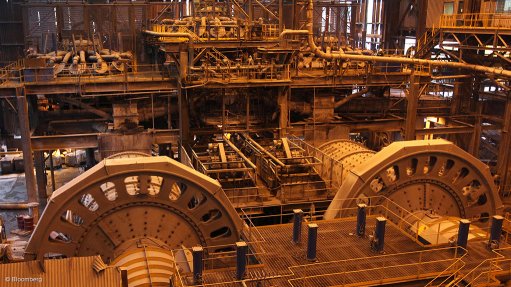
GOLD PROCESSING
Mechanisation works in operations specifically designed for it from the start
Photo by: Bloomberg
It is wishful thinking that mecha- nisation can be the ‘silver bullet’ to create a sustainable future for the South African gold mining industry, says Roger Dixon, chairperson and corporate consultant for SRK Consulting (SA), a firm of multidisciplinary consulting engineers and scientists.
Instead, he says, industry stakeholders should be squaring up to the formidable social and environmental challenges that the inevitable mine closures will bring.
The sector’s gradual but steady decline over recent decades is a sign of its natural trajectory, as operations deepen to reach remaining orebodies, grades drop and costs rise faster than returns.
Once the world’s number one gold producer - with gold production peaking at 1000 t/y in 1970 – South Africa is now in sixth position in the global rankings, producing just 150 t/y.
Employment has also dropped steadily; while the sector employed 550 000 workers in 1987, its workforce now only totals about 100 000, of which several thousand are currently at risk at unprofitable operations.
“Mechanisation is generally not an option in most South African gold mines. The only operations in which this really works are those specifically designed for it from the start – such as gold miners Harmony Gold’s Target gold mine, in Welkom, in the Free State, Gold Fields’ South Deep gold mine and Gold One’s Modder East gold mine, both in Johannesburg, Gauteng,” says Dixon.
He adds that the deep and narrow-reef conditions in older gold mines are not conducive to mecha- nisation, and few technological developments have been made in recent years to significantly address these constraints.
“Following gold reefs to greater depths has meant a steady increase in the costs of mining, which have not been matched by improvements in either productivity or gold grades. So, it is not difficult to understand the deterioration in mine viability over the years.”
Rapidly rising electricity prices have also impacted harshly on deep mines, as depth boosts key energy cost factors, such as refrigeration and rock hoisting.
“Apart from the sheer cost of electricity, the unreliability of power supply erodes mine productivity even further,” says Dixon. Capacity reductions and load-shedding have a hugely disruptive effect on mines, which comprise a complex set of integrated functions and, therefore, take days to fully resume efficient operational levels after power disruptions.”
The real issue for gold mining is how to better manage the unstoppable haemorrhage of jobs, says Dixon.
“The income of the average mineworker supports about eight people, so the knock-on effect of every lost job is massive. Alternative livelihoods should be a key focus of attention for all stakeholders.”
Dixon also highlights the potential environmental impacts of gold mine closures, which have become a source of contention between mining companies and the State.
“The full extent of environmental damage arising from gold mining may only emerge decades from now,” he says. “But, as we have witnessed with acid mine drainage around Johannesburg, the impacts and resultant costs will be substantial.”
He says it is time for stakeholders to “grasp the nettle” and put to rest any unrealistic notions of gold mining’s imminent revival.